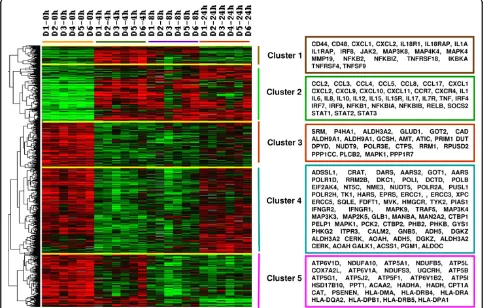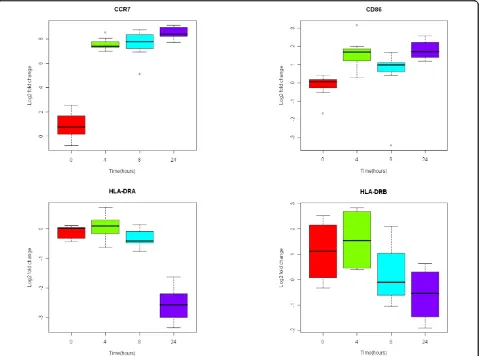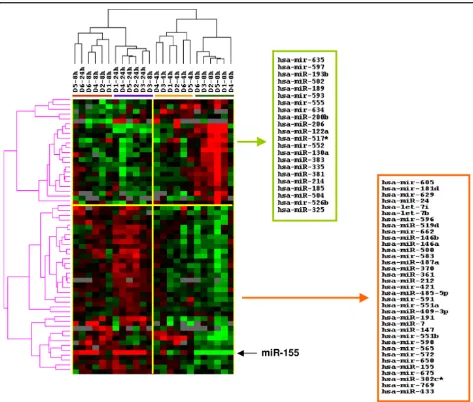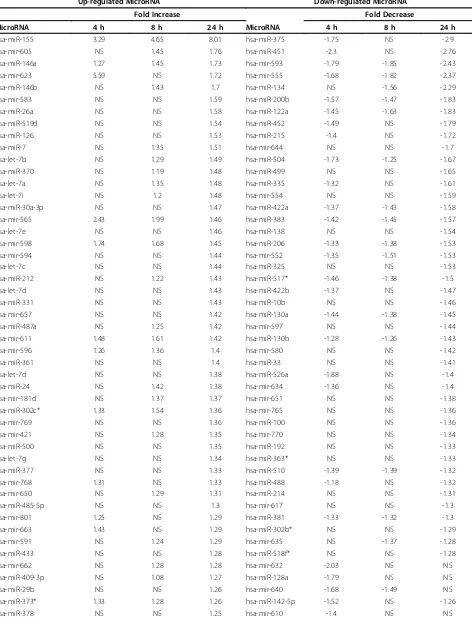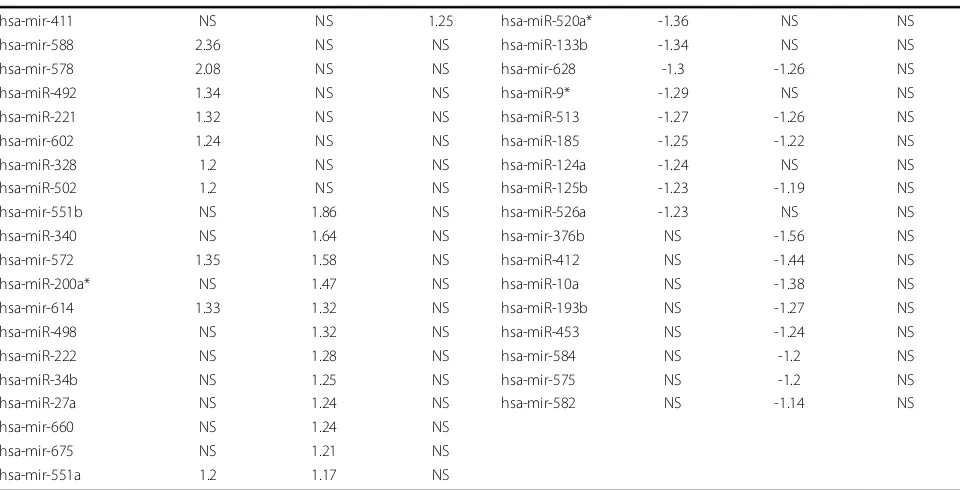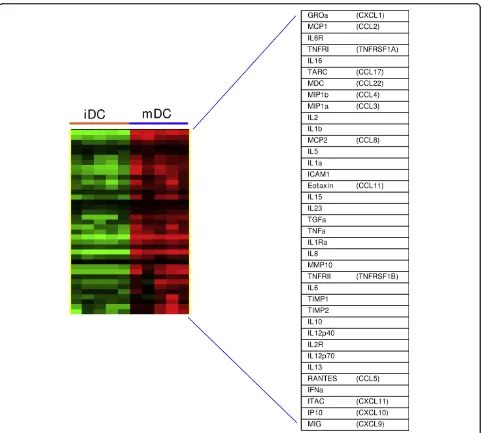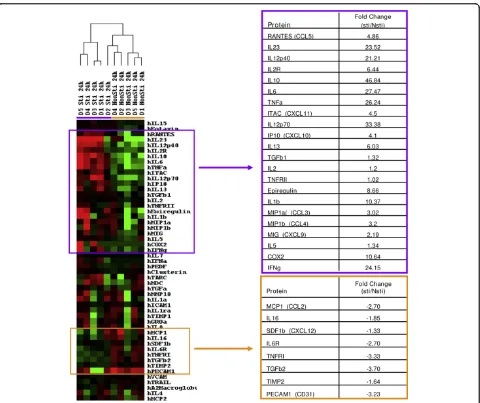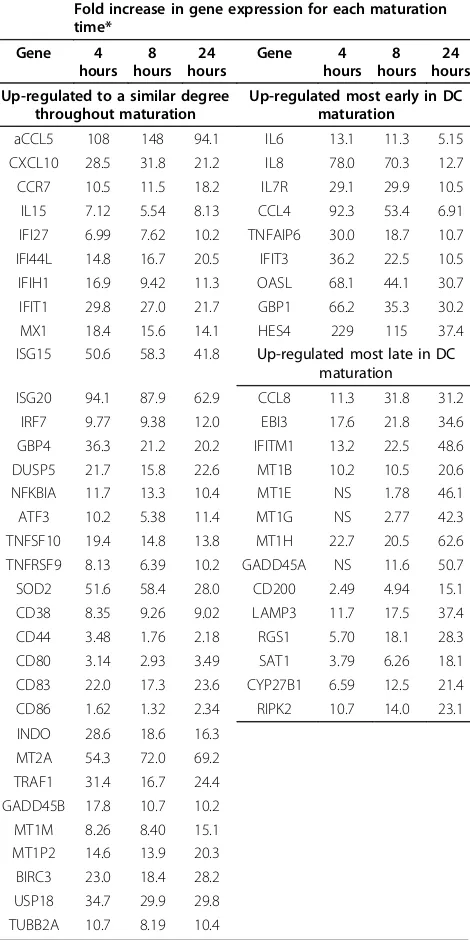R E S E A R C H
Open Access
Molecular signatures of maturing dendritic cells:
implications for testing the quality of dendritic
cell therapies
Ping Jin
1*†, Tae Hee Han
1,2†, Jiaqiang Ren
1, Stefanie Saunders
1, Ena Wang
1, Francesco M Marincola
1,
David F Stroncek
1Abstract
Background:Dendritic cells (DCs) are often produced by granulocyte-macrophage colony-stimulating factor (GM-CSF) and interleukin-4 (IL-4) stimulation of monocytes. To improve the effectiveness of DC adoptive immune cancer therapy, many different agents have been used to mature DCs. We analyzed the kinetics of DC maturation by lipopolysaccharide (LPS) and interferon-g(IFN-g) induction in order to characterize the usefulness of mature DCs (mDCs) for immune therapy and to identify biomarkers for assessing the quality of mDCs.
Methods:Peripheral blood mononuclear cells were collected from 6 healthy subjects by apheresis, monocytes were isolated by elutriation, and immature DCs (iDCs) were produced by 3 days of culture with GM-CSF and IL-4. The iDCs were sampled after 4, 8 and 24 hours in culture with LPS and IFN-gand were then assessed by flow cytometry, ELISA, and global gene and microRNA (miRNA) expression analysis.
Results:After 24 hours of LPS and IFN-gstimulation, DC surface expression of CD80, CD83, CD86, and HLA Class II antigens were up-regulated. Th1 attractant genes such as CXCL9, CXCL10, CXCL11 and CCL5 were up-regulated during maturation but not Treg attractants such as CCL22 and CXCL12. The expression of classical mDC biomarker genes CD83, CCR7, CCL5, CCL8, SOD2, MT2A, OASL, GBP1 and HES4 were up-regulated throughout maturation while MTIB, MTIE, MTIG, MTIH, GADD45A and LAMP3 were only up-regulated late in maturation. The expression of miR-155 was up-regulated 8-fold in mDCs.
Conclusion:DCs, matured with LPS and IFN-g, were characterized by increased levels of Th1 attractants as opposed to Treg attractants and may be particularly effective for adoptive immune cancer therapy.
Introduction
Dendritic cells (DC) are key players in both innate and adaptive immune responses. They are potent antigen pre-senting cells that recognize, process, and present antigens to T-cellsin vivo [1-3]. Consequently, DC-based immu-notherapy has become one of the most promising approaches for the treatment of cancer [4,5]. The fre-quency of DCs in the peripheral blood is naturally low and they are difficult to separate from other peripheral blood leukocytes [6], therefore, to enhance DC function, hematopoietic progenitor cells or peripheral blood
monocytes are usually used to produce mDCin vitroby culture with growth factors and cytokines [6,7].
Large quantities of mononuclear cells can easily be collected from the peripheral blood by leukapheresis. Monocytes can be isolated from other leukocytes col-lected by apheresis with high purity by adherence, elu-triation, or using immunomagnetic beads [8-10]. To produce immature DCs (iDCs), monocytes are usually incubated with granulocyte-macrophage colony-stimu-lating factor (GM-CSF) and interleukin-4 (IL-4). Because mature DCs (mDCs) are superior to iDCs for the stimu-lation of cytotoxic T-cells, iDCs derived from monocytes are often treated with various exogenous stimuli known to induce DCs maturation including lipopolysaccharide (LPS) and interferon-g(IFN-g) [5,11]. One of the goals * Correspondence: pjin@cc.nih.gov
†Contributed equally
1Department of Transfusion Medicine, Clinical Center, National Institutes of
Health, Bethesda, Maryland, USA
of this study was to characterize the molecular profile of
changes associated with LPS and IFN-g induced DC
maturation to estimate the effectiveness of these mDCs in adoptive immune cancer therapy.
When developing cellular therapies such as mDCs it is often necessary to compare products manufactured with a standard method and an alternative method. It is also necessary to determine if products manufactured from the starting material of different people are consistent or similar. Once the manufacturing process has been established and clinical products are being manufac-tured, clinical cellular therapies must also be assessed for potency. Another goal of this study was to identify molecular biomarkers that were associated with DC maturation and in order to characterize mDCs and that could be used for consistency, comparibility, and potency testing.
DCs are often assessed by flow cytometry for the expression of the costimulatory molecules CD80 and CD86, the maturation marker CD83, the chemokine receptor CCR7, and antigen presentation molecules, HLA class II antigens, to document the transition of iDCs to mDCs. Some cellular therapy laboratories also test the function of DCs by measuring their abil-ity to produce IL-12, IL-10, IL-23 or IFN-g following stimulation. However, the diverse functions of DC therapies indicate that additional biomarkers are necessory to characterize mDCs. Based on the multi-ple functions of DCs and their broad spectrum of effector molecules, it is highly improbable that a lim-ited number of biomarkers can adequately measure DC potency. But whole transcriptome expression ana-lysis and microRNA (miR) profiling anaana-lysis of the DC maturation process could provide better insight into DC biology and identify biomarkers that are indi-cators of DC potency.
Although monocytes, iDCs, and mDCs have been characterized at a molecular level, few studies have com-prehensively studied the molecular events associated with DC maturation. In this study we compared the kinetics of global changes of both gene and miR expres-sion associated with LPS and IFN-ginduced DC matura-tion. Gene and miR changes in DCs were assessed after 4, 8 and 24 hours of LPS and IFN-gstimulation. To vali-date the functional activity of DCs, we also tested solu-ble protein production in culture supernatant after 24 hours of maturation and after incubation with CD40 ligand transfected mouse fibroblasts.
Materials and methods Study design
Peripheral blood mononuclear cell (PBMC) concen-trates were collected using a CS3000 Plus blood cell separator (Baxter Healthcare Corp., Fenwal Division,
Deerfield, IL) from 6 healthy donors in the Depart-ment of Transfusion Medicine (DTM), Clinical Center, National Institutes of Health (NIH). All donors signed an informed consent approved by a NIH Institutional Review Board. Monocytes were isolated from the PBMC concentrates on the day of PBMC collection by elutriation (Elutra®, Gambro BCT, Lakewood, CO) using the instrument’s automatic mode according to the manufacturer’s recommendations. The monocytes were treated with GM-CSF (2000 IU/mL, R&D Sys-tems, Minneapolis, MN) and IL-4 (2000 IU/mL, R&D Systems) for 3 days to produce iDCs. The iDCs were then treated for 24 hours with LPS and IFN-gto pro-duce mDCs. The results of analysis of iDCs and mDCs by flow cytometry and gene expression profiling have been previously published [12].
DC preparation, maturation, and harvest
The elutriated monocytes from each donor were sus-pended at 6.7 × 106/mL with RPMI 1640 (Invitrogen, Carlsbad, CA) supplemented with 10% fetal calf serum (FSC) (Invitrogen), 2 mM L-glutamine (Invitrogen), 1% nonessential amino acids (Invitrogen), 1% pyruvate (Invitrogen), 100 units/mL penicillin/streptomycin
(Invi-trogen), and 50 μM 2-mercaptoethanol (Sigma, St
Louis, MO). A total of 10 mL of monocyte suspension was cultured in T25 culture flasks (Nalge Nunc Interna-tional, Rochester, NY) overnight in a humidified
incuba-tor with 5% CO2 at 37°C. On Day 1, 2000 IU/mL
human IL-4 (R&D Systems) and 2000 IU/mL GM-CSF (R&D Systems) were added to the culture. On Day 3, an additional 2000 IU/mL IL-4 and GM-CSF were added. To induce DC maturation, on day 4, 100 ng/mL LPS (Sigma) and 1000 IU/mL IFN-g (R&D Systems) were added. The DCs were harvested at 0, 4, 8 and 24 hours (h) after the addition of LPS and IFN-g. To remove the adherent DCs, 2 mM EDTA-PBS was added to each flask on ice. The harvested cells were pelleted, washed twice with HBSS, and resuspended in RPMI 1640. The total number of cells harvested and their via-bility was measured microscopically after adding Trypan Blue.
Flow cytometeric analysis
Analysis of DC function and cytokine generation
To measure DC cytokine production, iDC and mDCs (100,000 cells/ml) were co-incubated with 50,000 cells/ ml of adherent mouse fibroblasts transfected to express human CD40-Ligand (CD40L-LTK) in 48-well plates. This cell line was kindly provided by Dr. Kurlander (Department of Laboratory Medicine, Clinical Center, National Institutes of Health, Bethesda, MD). Before (0 hour) and after 24 hours of stimulation the supernatant was collected and the samples were analyzed by protein expression profiling. The levels of 50 soluble factors were assessed on an ELISA-based platform consisting of multiplexed assays that measured up to 16 proteins per well in standard 96 well plates (Pierce Search Light Pro-teome Array, Boston, MA)[13].
RNA preparation, amplification, and labeling for oligonucleotide microarray analysis
Total RNA was extracted from the DCs using Trizol (Invitrogen, Carlsbad, CA). RNA integrity was assessed using an Agilent 2100 Bioanalyser (Agilent Technolo-gies, Waldbronn, Germany). Total RNA (3 μg) from the DCs was amplified into anti-sense RNA (aRNA). While total RNA from PBMCs pooled from the 6 normal donors was extracted and amplified into aRNA to serve as the reference. Pooled reference and test aRNA were isolated and amplified using identical conditions and the same amplification/hybridization procedures to avoid possible interexperimental biases. Both reference and test aRNA were directly labeled using ULS aRNA Fluor-escent Labeling kit (Kreatech, Amsterdam, Netherlands) with Cy3 for reference and Cy5 for test samples.
Human oligonucleotide microarrays spanning the entire genome were printed in the Infectious Disease and Immunogenetics Section, DTM, Clinical Center, NIH using a commercial probe set containing 35,035 oligonu-cleotide probes, representing approximately 25,100 unique genes and 39,600 transcripts excluding control oligonucleotides (Operon Human Genome Array-Ready Oligo Set version 4.0, Huntsville, AL, USA). The design of the probe set was based on the Ensemble Human Database build (NCBI-35c), with full coverage of the NCBI human Reference sequence dataset (April 2, 2005). The microarray was composed of 48 blocks with one spot printed per probe per slide. Hybridization was car-ried out in a water bath at 42°C for 18 to 24 hours and the arrays were then washed and scanned on a GenePix scanner Pro 4.0 (Axon, Sunnyvale, CA) with a variable photomultiplier tube to obtain optimized signal intensi-ties with minimum (<1% spots) intensity saturation.
miR expression analysis
A miRNA probe set was designed using mature anti-sense miRNA sequences (Sanger data base, version 9.1)
consisting of 827 human, mouse, rat and virus probes plus two control probes. The probes were 5’ amine modified and printed in duplicate in the Immunoge-netics Section of the DTM on CodeLink activated slides (General Electric, GE Health, NJ, USA) via covalent bonding. 3 μg total RNA was directly labeled with miR-CURY™LNA Array Power Labeling Kit (Exiqon) accord-ing to manufacturer’s procedure. The total RNA from Epstein-Barr virus (EBV)-transformed lymphoblastoid cell line was used as the reference for the miRNA expression assay. The test samples were labeled with Hy5 and the references with Hy3. After labeling, both the sample and the reference were co-hybridized to the miRNA array at room temperature overnight and the slides were washed and scanned by GenePix scanner Pro 4.0 (Axon, Sunnyvale, CA, USA).
Data processing and statistical analyses
The raw data set was filtered according to a standard procedure to exclude spots below a minimum intensity that arbitrarily was set to an intensity parameter of 200 for the oligonucleotide arrays and 100 for the miR arrays in both fluorescence channels. If the fluorescence intensity of one channel was great than 200 for oligonu-ceotide array (100 for miR array), but the other was below 200(100), the fluorescence of the low intensity channel was arbitrarily set to 200(100). Spots with dia-meters <20 μm from oligonucleotide arrays, <10 μm from microRNA arrays and flagged spots were also excluded from the analysis. The filtered data was then normalized using the median over the entire array and retrieved by the BRB-ArrayTools http://linus.nci.nih.gov/ BRB-ArrayTools.html which was developed at the National Cancer Institute (NCI), Biometric Research Branch, Division of Cancer Treatment and Diagnosis. Hierarchical cluster analysis and TreeView software were used for visualization of the data [14,15]. Gene annotation and functional pathway analysis was based on the Database for Annotation, Visualization and Inte-grated Discovery (DAVID) 2007 software [16] and Gen-eCards website http://www.genecards.org/index.shtml.
miR and gene expression analysis by quantitative PCR To validate the results of the microarray analysis, three miR and 4 genes were selected for analysis by quantitive real-time/reverse-transcription polymerase chain reaction (RT-PCR). miR expression was measured and quantified by TaqMan MicroRNA Assays (Applied Biosystems, Fos-ter City, CA). Quantitative RT-PCR for 146a, miR-146b, and miR-155 were performed according to the
manufacturer’s protocol and normalized by RNU48
and CD86 (Assay ID Hs00199349_m1) were quantified by TaqMan Gene Expression Assays (Applied Biosys-tems) according to manufacturers’protocol and normal-ized by GAPDH (Assay ID Hs99999905_m1). Differences in expression were determined by the relative quantifica-tion method; the Ct values of the test genes were normal-ized to the Ct values of endogenous control GAPDH. The fold change or the relative quantity (RQ) was calcu-lated based on RQ = 2-ΔCt, whereΔCt = average Ct of test sample - average Ct of endogenous control sample.
Results
Changes in DC antigen expression
Immature DCs were produced from peripheral blood monocytes from 6 healthy subjects by stimulation with GM-CSF and IL-4 for 3 days. The iDCs were further sti-mulated with LPS and IFN-gand the expression of sur-face markers CD80, CD83, CD86, and HLA-DR were analyzed by flow cytometry before and after 4, 8, and 24 hours of LPS and IFN-gstimulation. The expression of all 4 antigens increased during maturation (Table 1).
Kinetics of the gene expression changes during DC maturation
Global gene expression was assessed in DCs from the 6 subjects pre-treatment (time 0, iDCs) and after 4, 8 and 24 hours of LPS and IFN-gstimulation. A total of 2,370 genes differed significantly among the matura-tion time groups (F-test; p < 0.001). Supervised hier-archical clustering revealed distinct clusters of genes that characterized each of the maturation times (Figure 1). Genes in clusters 1 and 2 were up-regulated during maturation and those in clusters 3, 4, and 5 were down-regulated. At hours 4 and 8, genes in clus-ter 1 were up-regulated compared to iDCs but returned to base levels after 24 hours. Cluster 2 genes were up-regulated on hours 4 through 24 of matura-tion. Cluster 3 and 4 genes were down-regulated on hours 4 and 8 but then returned to baseline levels after 24 hours. However the level of expression of genes in cluster 4 was greater after 24 hours than those in cluster 3. After 4 hours the expression of genes in cluster 5 were similar to baseline levels, but were then down-regulated on hours 8 and 24.
Canonical pathway analysis showed that genes in each of these 5 clusters belong to different pathways (See addi-tional file 1, table S1). Genes in Clusters 1 and 2 were most likely to be in pathways involved with the cellular immune response (See additional file 1, table S1, bold and *), cytokine signaling (See additional file 1, table S1, italics and #), transcriptional regulation and the inflam-matory response. This is consistent with cells that are ready to respond or are already responding to external stimuli. In contrast, genes in Clusters 3 and 4 were most likely to belong to pathways involved with metabolism (See additional file 1, table S1, bold and†). Genes in Cluster 5 also belonged to metabolism pathways as well as Humoral Immune Response and Pathogen-Influenced Signaling Pathways (See additional file 1, table S1, italics and $). The specific genes that were differentially expressed among the DCs stimulated with LPS and IFN-g for different durations of time and their fold-changes are summarized in Tables S2 and S3 [see Additional Files 2 and 3] (t-test, p≤0.001 compared to hr 0).
The genes up-regulated during DC maturation included many involved with immune function, cell dif-ferentiation, and migration. Several chemokines and their ligands were up-regulated during maturation. For exam-ple CCR7, which enhances the ability of DCs to migrate to lymphoid nodes was markedly up-regulated during maturation. Its expression was increased more than 10-fold at all times during maturation and was greatest after 24 hours of maturation (up-regulated 18-fold). Moreover, the expression of Oncostatin M (OSM), which enhances the expression of the CCR7 ligand CCL21 by microvas-cular endothelial cells and increases the efficiency of den-dritic cell trafficking to lymph nodes [17], was increased 5- to 6-fold during maturation. In addition, CXCR4, a chemokine receptor involved with DC migration to lym-phoid nodes, was up-regulated 3-fold after 24 hours of maturation [18]. However, the expression of several inflammatory chemokine receptors including CCR1 and CCR2 fell during maturation.
[image:4.595.59.542.643.713.2]The expression of inflammatory chemokine ligands including CCL2 (MCP-1), CCL3 (MIP1a), CCL4 (MIP1b), CXCL1 (GROa) and CXCL9, reached a peak at 4 hours of maturation but then rapidly returned to baseline levels. However, the expression of chemokines CCL5 (RANTES),
Table 1 Comparison of DC expression of CD14, CD80, CD83, CD86, and HLA-DR antigens according to maturation time
Percent of DCs expressing each antigen*
Maturation Time CD80 CD83 CD86 CD83 & CD86 HLA-DR CD14
0 h 29.2 ± 9.5 36.6 ± 11.9 26.0 ± 13.2 20.8 ± 14.5 80.6 ± 10.3 0.22 ± 0.11
4 h 47.6 ± 16.9 67.4 ± 14.6 82.8 ± 6.3 69.0 ± 7.8 93.7 ± 3.6 0.18 ± 0.17
8 h 79.3 ± 12.7 80.0 ± 11.5 90.9 ± 6.2 81.6 ± 13.3 95.6 ± 2.2 0.19 ± 0.14
24 h 89.6 ± 7.5 93.8 ± 6.3 96.7 ± 1.8 97.8 ± 0.6 98.2 ± 1.1 0.10 ± 0.07
CCL8 (MCP-2), and CXCL10 peaked after 8 hours and sustained high expression levels through 24 hours. Chemo-kine ligands that were part of Toll-like receptor signaling pathways, such as CCL3, CCL4, CCL5, CXCL9 (MIG), CXCL10 (IP-10), and CXCL11 (ITAC), were all up-regu-lated more than 7-fold during maturation. The levels of most of these genes peaked at hour 4 except for CCL5 and CXCL10 which peaked at hour 8 and sustained high levels of expression through hour 24. Chemokine ligands that preferentially attract Th1 T cells such as CXCL9, CXCL10, and CXCL11 were also markedly increased after 4 hours. However, two chemokine ligands for CCR4, which are important attractants of Th2 cells CCL17 (TARC) and CCL22 (MDC), were only slightly up-regulated or showed no significant change after 24 hours of maturation.
The expression of proinflamatory cytokines such as IL-1b (IL-1B), IL-6, IL-8, IL-15, and TNF were up-regulated more than 10-fold and their expression reached a peak after 4 hours. The expression of 12p40 (IL12B), 10 and IL-27 were up-regulated less than 10-fold after 4 hours of maturation and remained at the same level after 24 hours.
The costimulatory molecules, CD80 and CD86, and maturation marker CD83, all classic DC surface mar-kers, were up-regulated durning DC maturation [see Additional File 2, Table S2]. The expression of all three was above baseline levels throughout maturation. The expression of CD83 was markedly increased, 17- to 23-fold, compared to 1.3- to 3.5-fold for CD80 and CD86.
Genes encoding the major histocompatibility complex (MHC) Class I molecules (HLA-A, B, C, F, G, and H), pro-teosome activator subunit 2 (PSME2), and antigen peptide transport 1-2 (TAP1, 2) which are important for antigen processing and presentation were all up-regulated more than 2-fold through the 24 hours of maturation(see addi-tional file 2, table S2). Interestingly, MHC Class II genes were down-regulated during maturation, although analysis by flow cytometry showed that the expression cell surface HLA-DR protein increased during maturation (Table 1).
[image:5.595.56.540.91.399.2]The transcription factor RelB, which is essential for the development and function of DCs, was up-regu-lated approximately 3-fold at 4 and 8 hours of matura-tion and 6-fold after 24 hours. This transcript factor
directs the development of CD14+ monocytes to mye-loid DCs rather than to macrophages. Another family of transcription factors which are involved in DC dif-ferentiation and function are the Interferon regulatory factors (IRFs). Two members of this family are espe-cially important, IRF4 and IRF8, and both were up-regulated during DC maturation. SOCS1 (Suppressors of cytokine signaling 1) which has been shown to play a major role in regulation DC was increased 1.6-fold after 4 hours and SOCS2 expression was increased 4.8-to 5.7-fold throughout maturation(see additional file 2, table S2).
The expression of some genes was greatest in mDCs. Among these genes, two involved with antigen presenta-tion, LAMP3 and MARCKSL1, were up-regulated 4 hours after LPS and IL-4 stimulation and their expression con-tinued to increase throughout the study period. The maxi-mum change in expression of LAMP3 and MARCKSL1 were observed after 24 hours of maturation with a 37-fold and 21-fold increase respectively. The expression of the cell cycle and cell signaling genes GADD45A and RGS1 also increased most after 24 hours of maturation. Their expression peaked with 50-fold and 28-fold up-regulation respectively(see additional file 2, table S2).
Genes that were down-regulated during DC matura-tion included CD1C, CD33 and CD14. CD14 was only down-regulated 1.5- to 2.0-fold during the 24 hour per-iod, but CD33 was down-regulated 6- to 64-fold and CD1C was down-regulated 57- to 81-fold (see additional file 3, table S3).
To validate the microarray results, 4 genes (HLA-DRA, HLA-DRB1, CCR7, and CD86) were selected for analysis by quantitive RT-PCR. HLA-DRA and HLA-DRB1 were selected because although the expression of HLA Class II antigens are increased in mDCs, microarray analysis found that the expression HLA-DRA and HLA-DRB1 were down-regulated. CCR7 and CD86 were selected because microarray analysis showed that the expression of both genes were up-regulated during DC maturation. In addition, CCD7 is an important chemotaxis receptor and CD86 and important costimulatory molecule. The results from quantitive RT-PCR were consistent from those obtained with the microarrays (Figure 2).
miR expression during DC maturation
The expression of miR was also measured during DC maturation. Among the 474 miR analyzed 57 were dif-ferentially expressed (F-test, p ≤ 0.05) and were pre-sent in more than 80% of the samples. Hierarchical cluster analysis separated the samples into 2 major groups; an early group which included DCs samples treated with LPS and IFN-g for 0 and 4 hours and a late group which containing DC samples treated with LPS and IFN-gfor 8 and 24 hours (Figure 3). Both the
early and late groups contained two subgroups. The samples in these four subgroups were separated according to maturation time; hours 0, 4, 8 and 24. In contrast to gene expression, where several patterns or waves of expression were noted, only two general pat-terns were noted for miR analysis: miR whose expres-sion decreased with maturation and miR whose expression increased with maturation. Compared with iDC, 155, 605, 146a, 146b, 623, 583, 26a, 519d, 126, and miR-7 were significantly up-regulated in mDC. miR-155 was up-regulated the most (8-fold) after 24 hours. The other miRs were up-regulated 1.5- to 1.76-fold. miR-375, miR-451, miR-593, miR-555, and miR-134 were down-regulated significantly (2.3- to 2.9-fold) after 24 hours (Table 2).
To validate the miR microarray results, miR-146a, miR-146b, miR-155, were selected for analysis by quan-titative RT-PCR. These miR was selected because they have been previously found to be expressed by macro-phages or DCs [19-21]. The results were consistent with those obtained with the microarrays (Figure 4).
Proteins Produced during DC maturation
The levels of 50 proteins were measured in DC culture supernatants at time 0 and after 24 hours of maturation. The proteins whose levels changed significantly (t-tests, p < 0.05) were visualized by a heatmap (Figure 5). The levels of 16 proteins related to the DC function
increased including CXCL1 (GROa), CCL2 (MCP1),
CCL3 (MIP1a), CCL4 (MIP1b), CCL5 (RANTES), CCL8 (MCP2), CCL11 (Eotaxin), CCL17 (TARC), CCL22 (MDC), CXCL9 (MIG), CXCL10 (IP10), CXCL11 (ITAC), IL-6, IL-8, IL-10, IL-12 and TNF-a[see Addi-tional File 4, Table S4]. These results are consistent with the changes in gene expression levels.
Discussion
The use of DC-based cellular therapies to enhance innate and adoptive immune mediated tumor rejection is a very promising regimen which has shown evidence of improving patient survival and objectively enhancing tumor elimination. Numerous DC maturation protocols have been developed and each one has unique features to enhance DC function. In this study, we used a classi-cal iDC generation procedure that makes use of GM-CSF plus IL-4 stimulation which was followed by LPS plus IFN-gmaturation. We studied changes in gene and miR expression in maturing DCs to characterize the nat-ure of the mDCs produced with LPS and IFN-gand to identify genes and miR that could serve as biomarkers for the characterization mDCs
Our study demonstrated that after 24 hours of stimu-lation with LPS and IFN-g, mDCs expressed increased levels of HLA Class I and Class II antigens as well as
the costimulatory molecules CD80, CD86 and the che-motaxic receptor CCR7. The mDCs were also well-armed to induce Th1 responses as exemplified by signif-icant elevations in the expression of the Th1 cell attrac-tants CXCL9, CXCL10, CXCL11 and CCL5. Another factor used for DC maturation, prostaglandin E2 (PGE2), induces mDCs which produced high levels of the regulator T cell (Treg) attracting cytokines CCL22 and CXCL12 [22]. These Treg cells can counter the effects of Th1 responses by cytotoxic T cells, Th1 cells, and NK cells. In contrast, we found that LPS and IFN-g maturated DCs did not increase the levels of CCL22 and CXCL12 expression.
We found that the expression of a number of other genes were up-regulated during DC maturation. The up-regulated genes during DC fell into three general categories: those that were up-regulated to a similar level throughout maturation, those that were most
[image:7.595.60.539.89.445.2]regulated early in maturation and those that were most up-regulated after 24 hours of maturation. Genes whose expression was up-regulated throughout maturation were most likely to belong to several pathways involved with inflammation: interferon signaling, IL-10 signaling, CD40 signaling, IL-6 signaling, activation of IRF by cyto-solic pattern recognition receptors and role of pattern recognition receptors in recognition of bacteria and virus pathways. Specific genes that were up-regulated throughout maturation include CCL3, CCL4, CCL5, CCL8, CXCL10, CXCL11, CCR7, 1b, 6, 15, IL-27, IL-7R, IL-10RA, IL-15RA, STAT1, STAT2, STAT3, CD80, CD83, and CD86. Among the genes that were
markedly up-regulated (more than 10-fold) during maturation and are good potential mDC biomarkers are CCL5, CXCL10, CCR7, IFI44L, IFIH1, MX1, ISG15, ISG20, INDO, MT2A, TRAF1, BRIC3, USP18, and CD83 (Table 3). CCL5, CCR7, and CD83 may be parti-cularly good potency biomarker candidates because they have important roles in DC function.
[image:8.595.57.530.90.492.2]Genes whose expression was most up-regulated early in maturation included genes in the NF-kB signaling; IL-6, IL-8, IL-10, IL-15 and IL-17 signaling; 4-1 bb sig-naling in T lymphocytes; MIF regulation of innate immunity; and role of pattern recognition receptors in the recognition of bacteria and viruses pathways.
Table 2 MicroRNA (miRNA) whose expression changed in iDCs following LPS and IFN-gstimulation (T-test, p≤0.05)
Up-regulated MicroRNA Down-regulated MicroRNA
Fold Increase Fold Decrease
MicroRNA 4 h 8 h 24 h MicroRNA 4 h 8 h 24 h
hsa-miR-155 3.29 4.65 8.01 hsa-miR-375 -1.75 NS -2.9
hsa-mir-605 NS 1.45 1.76 hsa-miR-451 -2.3 NS -2.76
hsa-miR-146a 1.27 1.45 1.73 hsa-mir-593 -1.79 -1.85 -2.43
hsa-mir-623 5.59 NS 1.72 hsa-mir-555 -1.68 -1.82 -2.37
hsa-miR-146b NS 1.43 1.7 hsa-miR-134 NS -1.56 -2.29
hsa-mir-583 NS NS 1.59 hsa-miR-200b -1.57 -1.47 -1.83
hsa-miR-26a NS NS 1.58 hsa-miR-122a -1.45 -1.63 -1.83
hsa-miR-519d NS NS 1.54 hsa-miR-452 -1.49 NS -1.79
hsa-miR-126 NS NS 1.53 hsa-miR-215 -1.4 NS -1.72
hsa-miR-7 NS 1.35 1.51 hsa-mir-644 NS NS -1.7
hsa-let-7b NS 1.29 1.49 hsa-miR-504 -1.73 -1.25 -1.67
hsa-miR-370 NS 1.19 1.48 hsa-miR-499 NS NS -1.65
hsa-let-7a NS 1.35 1.48 hsa-miR-335 -1.32 NS -1.61
hsa-let-7i NS 1.2 1.48 hsa-mir-554 NS NS -1.59
hsa-miR-30a-3p NS NS 1.47 hsa-miR-422a -1.37 -1.43 -1.58
hsa-mir-565 2.43 1.99 1.46 hsa-miR-383 -1.42 -1.45 -1.57
hsa-let-7e NS NS 1.46 hsa-miR-138 NS NS -1.54
hsa-mir-598 1.74 1.68 1.45 hsa-miR-206 -1.33 -1.38 -1.53
hsa-mir-594 NS NS 1.44 hsa-mir-552 -1.35 -1.51 -1.53
hsa-let-7c NS NS 1.44 hsa-miR-325 NS NS -1.53
hsa-miR-212 NS 1.22 1.43 hsa-miR-517* -1.46 -1.38 -1.5
hsa-let-7d NS NS 1.43 hsa-miR-422b -1.37 NS -1.47
hsa-miR-331 NS NS 1.43 hsa-miR-10b NS NS -1.46
hsa-mir-657 NS NS 1.42 hsa-miR-130a -1.44 -1.38 -1.45
hsa-miR-487a NS 1.25 1.42 hsa-mir-597 NS NS -1.44
hsa-mir-611 1.48 1.61 1.42 hsa-miR-130b -1.28 -1.26 -1.43
hsa-mir-596 1.26 1.36 1.4 hsa-mir-580 NS NS -1.42
hsa-miR-361 NS NS 1.4 hsa-miR-33 NS NS -1.41
hsa-let-7d NS NS 1.38 hsa-miR-526a -1.88 NS -1.4
hsa-miR-24 NS 1.42 1.38 hsa-mir-634 -1.36 NS -1.4
hsa-mir-181d NS 1.37 1.37 hsa-mir-651 NS NS -1.38
hsa-miR-302c* 1.33 1.54 1.36 hsa-mir-765 NS NS -1.36
hsa-mir-769 NS NS 1.36 hsa-miR-100 NS NS -1.36
hsa-mir-421 NS 1.28 1.35 hsa-mir-770 NS NS -1.34
hsa-miR-500 NS NS 1.35 hsa-miR-192 NS NS -1.33
hsa-let-7g NS NS 1.34 hsa-miR-363* NS NS -1.33
hsa-miR-377 NS NS 1.33 hsa-miR-510 -1.39 -1.39 -1.32
hsa-mir-768 1.31 NS 1.33 hsa-miR-488 -1.18 NS -1.32
hsa-mir-650 NS 1.29 1.31 hsa-miR-214 NS NS -1.31
hsa-miR-485-5p NS NS 1.3 hsa-mir-617 NS NS -1.3
hsa-mir-801 1.25 NS 1.29 hsa-miR-381 -1.33 -1.32 -1.3
hsa-mir-663 1.43 NS 1.29 hsa-miR-302b* NS NS -1.29
hsa-mir-591 NS 1.24 1.29 hsa-mir-635 NS -1.37 -1.28
hsa-miR-433 NS NS 1.28 hsa-miR-518f* NS NS -1.28
hsa-mir-662 NS 1.28 1.28 hsa-mir-632 -2.03 NS NS
hsa-miR-409-3p NS 1.08 1.27 hsa-miR-128a -1.79 NS NS
hsa-miR-29b NS NS 1.26 hsa-mir-640 -1.68 -1.49 NS
hsa-miR-373* 1.33 1.28 1.26 hsa-miR-142-5p -1.52 NS -1.26
Table 2: MicroRNA (miRNA) whose expression changed in iDCs following LPS and IFN-gstimulation (T-test, p≤0.05)(Continued)
hsa-mir-411 NS NS 1.25 hsa-miR-520a* -1.36 NS NS
hsa-mir-588 2.36 NS NS hsa-miR-133b -1.34 NS NS
hsa-mir-578 2.08 NS NS hsa-mir-628 -1.3 -1.26 NS
hsa-miR-492 1.34 NS NS hsa-miR-9* -1.29 NS NS
hsa-miR-221 1.32 NS NS hsa-miR-513 -1.27 -1.26 NS
hsa-mir-602 1.24 NS NS hsa-miR-185 -1.25 -1.22 NS
hsa-miR-328 1.2 NS NS hsa-miR-124a -1.24 NS NS
hsa-miR-502 1.2 NS NS hsa-miR-125b -1.23 -1.19 NS
hsa-mir-551b NS 1.86 NS hsa-miR-526a -1.23 NS NS
hsa-miR-340 NS 1.64 NS hsa-mir-376b NS -1.56 NS
hsa-mir-572 1.35 1.58 NS hsa-miR-412 NS -1.44 NS
hsa-miR-200a* NS 1.47 NS hsa-miR-10a NS -1.38 NS
hsa-mir-614 1.33 1.32 NS hsa-miR-193b NS -1.27 NS
hsa-miR-498 NS 1.32 NS hsa-miR-453 NS -1.24 NS
hsa-miR-222 NS 1.28 NS hsa-mir-584 NS -1.2 NS
hsa-miR-34b NS 1.25 NS hsa-mir-575 NS -1.2 NS
hsa-miR-27a NS 1.24 NS hsa-mir-582 NS -1.14 NS
hsa-mir-660 NS 1.24 NS
hsa-mir-675 NS 1.21 NS
hsa-mir-551a 1.2 1.17 NS
NS = not significant
[image:10.595.56.541.354.699.2]Specific genes that were most up-regulated early in
maturation include CXCL1, IL-1a, TNF, TNFSF8,
TNFAIP5, TNIP3, TRAF3, JAK2, BID, CASP1, LILRB1, LILRB2, IILRB3, 2NF422, MMP-10, IL-10, and IL-12b. Genes whose expression was markedly up-regulated early and are good biomarker candidates include: CCL4 (MIP-1b), HES4, GBP1, OSAL, IFIT3, IL-8, IL7R, and TNFAIP6 (Table 3).
The DC genes that were most up-regulated after 24-hours of stimulation, in general, included genes that belonged to metabolic pathways. However, a number of
inflammatory pathway genes were also in this group. Genes in this group included CXCR4, IFITM4P, IFITM1, GADD45A, LAMP3, TRAF5, STAT5, CASP3, GZMB, MTIB, MTIE, MTIG, MTIH, CCL8, HLA-A, HLA-B, HLA-C, and LYGE. Among these genes GADD45A, MTIE, and MTIG were not up-regulated after 4 hours, but were markedly up-regulated after 24 hours and may be especially good biomarker candidates (Table 3).
[image:11.595.58.542.86.519.2]Some genes were markedly down-regulated in mDCs including CD1C, MAF, and CLEC10A (Table 4). These
genes are also mDC biomarker candidates. The expres-sion of MHC Class II genes was down-regulated during maturation, but flow cytometer analysis showed that the cell surface expression of HLA-DR protein increased during maturation (Table 1). This observation suggests an active regulation of these genes at the transcription level. These transcripts could be sensored by the encoded protein and regulatory miR. This observation could also be explained by the fact that the majority of MHC II molecules are stored intracellularly within the internal vesicles of multivesicular bodies in iDCs. Thus MHC II antigen expression can increase while gene expression decreases.
Many cellular therapy laboratories use the produc-tion of IL-10 and IL-12 as mDC potency assays. We also found that the mDCs produced soluble IL-10 and IL-12. However, the expression of the genes encoding IL-10 and IL-12B(p40) were up-regulated 3- to 6-fold after 4 and 8 hours of LPS and IFN-g stimulation, but returned to baseline levels after 24 hours suggesting that these genes may not be good molecular biomarkers.
[image:12.595.59.539.86.489.2]miRs are endogenously encoded regulatory RNA which regulate mRNA by targeting their 3’UTR and inducing mRNA degradation or protein translation sup-pression. They are highly involved in development
timing, differentiation, and cell cycle regulation. To understand how miR expression is involved in DC maturation, we used miR array analysis. Unlike gene expression analysis, miR expression analysis of maturing DCs revealed two distinct patterns: down-regulation of groups of miR at 8 hours of maturation with sustained low expression throughout the rest of maturation and up-regulation of other groups of miR at 8 hours of maturation and sustained regulation. Among the up-regulated miR, the best candidate for potency testing is
miR-155. The expression of miR-155 increased more than any other miR with 3-fold up-regulation after 4 hours, 4-fold after 8 hours and 8-fold after 24 hours. This finding is supported by previous reports that miR-155 expression is increased in DC maturation [19-21]. Other miRs that may be good biomarkers are miR-146a and miR-146b, which we also found were up-regulated during DC maturation. These two miRs have also been found to be up-regulated in DCs matured with IL-1b, IL-6, TNFaand PGE2 [21].
Since miR control the expression of multiple genes and proteins, they may actually be better biomarkers of potency then single genes or proteins. miR-155 is located within the noncoding B cell integration cluster (Bic) gene [23] and is functionally important in B cell, T cell and macrophage biology. miR-155 is up-regulated in B cells exposed to antigen, in T cells stimulated by Toll-like receptor ligand and in macrophages by IFN-g stimu-lation[24,25]. The Toll-like receptor/interleukin-1 (TRL/ IL-1) inflammatory pathway appears to be a general tar-get of miR-155 [19]. One of the genes that it directly targets is the DC transcription factor PU.1 [20]. Further-more, miR-155 directly controls TAB2 a signal trans-duction molecule. miR-155 may be part of a negative feedback loop which down modules inflammatory cyto-kine production including IL-1bin response to LPS-sti-mulation [19]. Hence, miR-155 may be a particularly good mDC potency biomarker.
[image:13.595.305.540.111.293.2]The ability of these studies to identify mDC biomar-kers is some what limited by the variability of methods used to produce iDCs and mDCs among various labora-tories. We used a 3 day DC differentiation protocol that uses IL-4 and GM-CSF followed by differentiation with LPS and IFN-g. This method is very similar to that used in several clinical vaccine protocols involving mature
Table 3 Genes up-regulated during DC maturation that could be used as biomarkers for assessing mDCs
Fold increase in gene expression for each maturation time* Gene 4 hours 8 hours 24 hours Gene 4 hours 8 hours 24 hours
Up-regulated to a similar degree throughout maturation
Up-regulated most early in DC maturation
aCCL5 108 148 94.1 IL6 13.1 11.3 5.15
CXCL10 28.5 31.8 21.2 IL8 78.0 70.3 12.7
CCR7 10.5 11.5 18.2 IL7R 29.1 29.9 10.5
IL15 7.12 5.54 8.13 CCL4 92.3 53.4 6.91
IFI27 6.99 7.62 10.2 TNFAIP6 30.0 18.7 10.7
IFI44L 14.8 16.7 20.5 IFIT3 36.2 22.5 10.5
IFIH1 16.9 9.42 11.3 OASL 68.1 44.1 30.7
IFIT1 29.8 27.0 21.7 GBP1 66.2 35.3 30.2
MX1 18.4 15.6 14.1 HES4 229 115 37.4
ISG15 50.6 58.3 41.8 Up-regulated most late in DC maturation
ISG20 94.1 87.9 62.9 CCL8 11.3 31.8 31.2
IRF7 9.77 9.38 12.0 EBI3 17.6 21.8 34.6
GBP4 36.3 21.2 20.2 IFITM1 13.2 22.5 48.6
DUSP5 21.7 15.8 22.6 MT1B 10.2 10.5 20.6
NFKBIA 11.7 13.3 10.4 MT1E NS 1.78 46.1
ATF3 10.2 5.38 11.4 MT1G NS 2.77 42.3
TNFSF10 19.4 14.8 13.8 MT1H 22.7 20.5 62.6
TNFRSF9 8.13 6.39 10.2 GADD45A NS 11.6 50.7
SOD2 51.6 58.4 28.0 CD200 2.49 4.94 15.1
CD38 8.35 9.26 9.02 LAMP3 11.7 17.5 37.4
CD44 3.48 1.76 2.18 RGS1 5.70 18.1 28.3
CD80 3.14 2.93 3.49 SAT1 3.79 6.26 18.1
CD83 22.0 17.3 23.6 CYP27B1 6.59 12.5 21.4
CD86 1.62 1.32 2.34 RIPK2 10.7 14.0 23.1
INDO 28.6 18.6 16.3
MT2A 54.3 72.0 69.2
TRAF1 31.4 16.7 24.4
GADD45B 17.8 10.7 10.2
MT1M 8.26 8.40 15.1
MT1P2 14.6 13.9 20.3
BIRC3 23.0 18.4 28.2
USP18 34.7 29.9 29.8
TUBB2A 10.7 8.19 10.4
[image:13.595.57.292.113.583.2]Fold-increase compared to iDCs.
Table 4 Genes down-regulated during DC maturation that could be used as biomarkers for assessing mDCs
Fold decrease in gene expression for each maturation time*
Gene 4 hours 8 hours 24 hours
Genes down-regulated to a similar degree throughout maturation
CD1C 64.0 82.2 57.8
MYC 9.17 8.83 9.35
MAF 15.0 8.30 20.5
PTGS1 5.43 20.4 13.0
DOK2 8.78 7.03 9.63
Genes down-regulated most late in DC maturation
TGFBI 2.44 6.76 11.2
GATM 2.70 12.0 17.7
ARHGDIB 2.37 10.1 15.4
MRC1 NS 7.15 30.22
CLEC10A 3.82 28.2 43.5
DCs. However, other protocols use 5 to 8 days of IL-4 and GM-CSF culture to produce iDCs and a variety of other agents are being used for DC maturation. We also used FCS rather than human AB serum in these studies and this could have had some effects on DC maturation.
In conclusion, we found that LPS and IFN-ginduced mDCs expressed large quantities of Th1 attractants, but not Treg attractants, suggesting that these mDCs will be particularly effective for adoptive immune cancer ther-apy. In addition, we identified several genes and miRs that may be useful biomarkers for consistency, compar-ability, and potency testing. However, further studies are needed to validate their utility as biomarkers.
Additional file 1: Table S1: The 30 canonical pathways with the most differentially expressed DC genes for each of the 5 gene clusters. Canonical pathway analysis showed that genes in each of these 5 clusters belong to different pathways.
Click here for file
[ http://www.biomedcentral.com/content/supplementary/1479-5876-8-4-S1.DOC ]
Additional file 2: Table S2. Immature DC Genes whose expression was up-regulated following LPS and IFN-gstimulation. The specific genes that were differentially expressed among the DCs stimulated with LPS and IFN-gfor different durations of time and their fold-change, up-regulated genes summary. (t-test, p≤0.001 compared to hr 0). Click here for file
[ http://www.biomedcentral.com/content/supplementary/1479-5876-8-4-S2.DOC ]
Additional file 3: Table S3. Immature DC Genes whose expression was down-regulated following LPS and IFN-gstimulation. The specific genes that were differentially expressed among the DCs stimulated with LPS and IFN-gfor different durations of time and their fold-change, down-regulated genes summary. (t-test, p≤0.001 compared to hr 0).
Click here for file
[ http://www.biomedcentral.com/content/supplementary/1479-5876-8-4-S3.DOC ]
Additional file 4: Table S4. Soluble factor levels in DC cell culture supernatant whose expression was up-regulated following LPS and IFN-gstimulation. Soluble factor levels in DC cell culture supernatant whose expression was up-regulated following LPS and IFN-gstimulation. Click here for file
[ http://www.biomedcentral.com/content/supplementary/1479-5876-8-4-S4.DOC ]
Additional file 5: Table S5. Soluble factor levels and fold changes in mature DC culture supernatant after 24 hours of CD40 Ligand stimulation. Soluble factor levels and fold changes in mature DC culture supernatant after 24 hours of CD40 Ligand stimulation.
Click here for file
[ http://www.biomedcentral.com/content/supplementary/1479-5876-8-4-S5.DOC ]
Acknowledgements
We thank the staff of the NIH, Clinical Center, Dowling Clinic, Department of Transfusion Medicine, Clinical Center, NIH for collecting the cells and the Cell Processing Laboratory, Department of Transfusion Medicine, Clinical Center, NIH for preparing the elutriated cells. These studies were funded by the Department of Transfusion Medicine, Clinical Center, NIH.
Author details
1Department of Transfusion Medicine, Clinical Center, National Institutes of
Health, Bethesda, Maryland, USA.2Department of Laboratory Medicine, Inje University Sanggye Paik Hospital, Seoul, Korea.
Authors’contributions
PJ participated in the design of the study, performed experiments, analyzed the data and participated in writing the manuscript. THH participated in the design of the study, performed experiments, analyzed the data and participated in writing the manuscript. JR particapted in designing the study, performed experiments and analyzed data. SS performed experiments and analyzed data. EW participated in designing the study and the writing of the manuscript. FMM participated in designing the study and the writing of the manuscript. DFS participated in designing the study, coordinating the study and the writing of the manuscript. All authors have read and approved the final manuscript.
Competing interests
The authors declare that they have no competing interests.
Received: 2 September 2009
Accepted: 15 January 2010 Published: 15 January 2010
References
1. Hashimoto SI, Suzuki T, Nagai S, Yamashita T, Toyoda N, Matsushima K:
Identification of genes specifically expressed in human activated and mature dendritic cells through serial analysis of gene expression.Blood 2000,96:2206-2214.
2. Young JW, Merad M, Hart DN:Dendritic cells in transplantation and immune-based therapies.Biol Blood Marrow Transplant2007,13:23-32. 3. Randolph GJ, Jakubzick C, Qu C:Antigen presentation by monocytes and
monocyte-derived cells.Curr Opin Immunol2008,20:52-60.
4. Banchereau J, Palucka AK:Dendritic cells as therapeutic vaccines against cancer.Nat Rev Immunol2005,5:296-306.
5. Gilboa E:DC-based cancer vaccines.J Clin Invest2007,117:1195-1203. 6. Nicolette CA, Healey D, Tcherepanova I, Whelton P, Monesmith T,
Coombs L, Finke LH, Whiteside T, Miesowicz F:Dendritic cells for active immunotherapy: optimizing design and manufacture in order to develop commercially and clinically viable products.Vaccine2007,
25(Suppl 2):B47-B60.
7. Dauer M, Obermaier B, Herten J, Haerle C, Pohl K, Rothenfusser S, Schnurr M, Endres S, Eigler A:Mature dendritic cells derived from human monocytes within 48 hours: a novel strategy for dendritic cell differentiation from blood precursors.J Immunol2003,170:4069-4076. 8. Felzmann T, Witt V, Wimmer D, Ressmann G, Wagner D, Paul P, Huttner K,
Fritsch G:Monocyte enrichment from leukapharesis products for the generation of DCs by plastic adherence, or by positive or negative selection.Cytotherapy2003,5:391-398.
9. Wong EC, Maher VE, Hines K, Lee J, Carter CS, Goletz T, Kopp W, Mackall CL, Berzofsky J, Read EJ:Development of a clinical-scale method for generation of dendritic cells from PBMC for use in cancer immunotherapy.Cytotherapy2001,3:19-29.
10. Berger TG, Strasser E, Smith R, Carste C, Schuler-Thurner B, Kaempgen E, Schuler G:Efficient elutriation of monocytes within a closed system (Elutra) for clinical-scale generation of dendritic cells.J Immunol Methods 2005,298:61-72.
11. Albert ML, Jegathesan M, Darnell RB:Dendritic cell maturation is required for the cross-tolerization of CD8+ T cells.Nat Immunol2001,2:1010-1017. 12. Han TH, Jin P, Ren J, Slezak S, Marincola FM, Stroncek DF:Evaluation of 3
clinical dendritic cell maturation protocols containing lipopolysaccharide and interferon-gamma.J Immunother2009,32:399-407.
13. Panelli MC, White R, Foster M, Martin B, Wang E, Smith K, Marincola FM:
Forecasting the cytokine storm following systemic interleukin (IL)-2 administration.J Transl Med2004,2:17.
15. Eisen MB, Spellman PT, Brown PO, Botstein D:Cluster analysis and display of genome-wide expression patterns.Proc Natl Acad Sci USA1998,
95:14863-14868.
16. Dennis G Jr, Sherman BT, Hosack DA, Yang J, Gao W, Lane HC, Lempicki RA:
DAVID: Database for Annotation, Visualization, and Integrated Discovery.
Genome Biol2003,4:3.
17. Sugaya M, Fang L, Cardones AR, Kakinuma T, Jaber SH, Blauvelt A, Hwang ST:Oncostatin M enhances CCL21 expression by microvascular endothelial cells and increases the efficiency of dendritic cell trafficking to lymph nodes.J Immunol2006,177:7665-7672.
18. Kabashima K, Shiraishi N, Sugita K, Mori T, Onoue A, Kobayashi M, Sakabe J, Yoshiki R, Tamamura H, Fujii N, Inaba K, Tokura Y:CXCL12-CXCR4 engagement is required for migration of cutaneous dendritic cells.Am J Pathol2007,171:1249-1257.
19. Ceppi M, Pereira PM, Dunand-Sauthier I, Barras E, Reith W, Santos MA, Pierre P:MicroRNA-155 modulates the interleukin-1 signaling pathway in activated human monocyte-derived dendritic cells.Proc Natl Acad Sci USA2009.
20. Martinez-Nunez RT, Louafi F, Friedmann PS, Sanchez-Elsner T: MicroRNA-155 modulates pathogen binding ability of Dendritic Cells by down-regulation of DC-specific intercellular adhesion molecule-3 grabbing non-integrin (DC-SIGN).J Biol Chem2009.
21. Holmstrom K, Pedersen AW, Claesson MH, Zocca MB, Jensen SS:
Identification of a microRNA signature in dendritic cell vaccines for cancer immunotherapy.Hum Immunol2009.
22. Muthuswamy R, Urban J, Lee JJ, Reinhart TA, Bartlett D, Kalinski P:Ability of mature dendritic cells to interact with regulatory T cells is imprinted during maturation.Cancer Res2008,68:5972-5978.
23. Lagos-Quintana M, Rauhut R, Yalcin A, Meyer J, Lendeckel W, Tuschl T:
Identification of tissue-specific microRNAs from mouse.Curr Biol2002,
12:735-739.
24. O’Connell RM, Rao DS, Chaudhuri AA, Boldin MP, Taganov KD, Nicoll J, Paquette RL, Baltimore D:Sustained expression of microRNA-155 in hematopoietic stem cells causes a myeloproliferative disorder.J Exp Med 2008,205:585-594.
25. Rodriguez A, Vigorito E, Clare S, Warren MV, Couttet P, Soond DR, van DS, Grocock RJ, Das PP, Miska EA, Vetrie D, Okkenhaug K, Enright AJ, Dougan G, Turner M, Bradley A:Requirement of bic/microRNA-155 for normal immune function.Science2007,316:608-611.
doi:10.1186/1479-5876-8-4
Cite this article as:Jinet al.:Molecular signatures of maturing dendritic cells: implications for testing the quality of dendritic cell therapies. Journal of Translational Medicine20108:4.
Submit your next manuscript to BioMed Central and take full advantage of:
• Convenient online submission • Thorough peer review
• No space constraints or color figure charges • Immediate publication on acceptance
• Inclusion in PubMed, CAS, Scopus and Google Scholar
• Research which is freely available for redistribution

